The best of times, the worst of times
I first met Gila Chevillon when I was walking the GR10, at the hostel she now runs at Esbintz (also known as Esbints) in the Ariège. In the evening she fed us a copious couscous. Sitting in her stone flagged kitchen at an immensely solid wooden table, there were several walkers and a young woman who wanted to be a shepherdess. She had come to work with Gila’s husband Francis for a few weeks. So the conversation centred around Gila’s early experiences as a shepherdess in the estive, the pastures high up in the mountains, where the sheep go for their summer holidays.
“That year was exceptional. It isn’t normally like it was for me, and isn’t like that now,” she insisted. “When I started in 1979 there were no shepherdesses. It wasn’t the done thing for a young woman to go up into the mountains on her own. What would an honest woman be doing up there with all those lonely virile shepherds? I overheard some remarks when I went to the market. I could have been upset, but it was too ridiculous. I decided to laugh them off.”
Previously she had taught biology and physical education in a secondary school in Germany. “At that time, I had plenty of money, everything that I wanted, but I didn’t want to live like everyone else. I wanted adventure. Up there, being in the mountains, was an adventure. I had a little French but I knew nothing about the Ariège and less about farming. It was wonderful and terrible all at the same time.”
The next day I continued my walk towards the Mediterranean, but I wanted to find out more so I arranged to meet her again.
Accident
“In the summer of 1978, I became a shepherdess by accident,” she told me. “A really serious accident, on the mountain. A shepherd friend had slipped on the snow and fell through the crust – it was hollow underneath. It wasn’t a big hole, he only fell two metres, but he landed with his back on a rock and broke his spine. It was just chance that Francis and I went up to see him.”
Gila and Francis replaced their friend for the rest of the season. Francis had just finished his training. The next year Gila took the sheep-herding course and was sent off to her mountain, to look after flocks belonging to several sheep farmers. She kept a diary and has let me reproduce some entries here, in green.
After much preparation of the ewes over the last few days, so they are healthy and look good – we have painted all the collars for the bells – we are going up.
Around 11 o’clock in the evening I prepare the last rucksack and I am ready, excited by the prospect. Around 2 o’clock in the morning we set off. Shamboo [the sheepdog] goes ahead and we bring the ewes down under the full moon, which means that they can eat a little. It is magnificent. The bells sound so beautiful in the streets of Seix. Only the baker and two girls see us passing through. We wait for Jean’s flock until 4:30. Then the bells can be heard in the distance, far away, approaching slowly. Impressive meeting of the two flocks.
[later] With the stifling heat, the sheep already have their heads to the ground. We are the same, heads bent forward from fatigue and the weight of the heavy rucksacks. It is steep for me, sometimes I can’t take it any more. Three sheep overtake me, then I overtake them, an endless game which continues as far as the edge of the woods. Then I give up, sit down to let them pass in front of me. The prospect of the hut and a rest keep us going – and for me the prospect of being there.
Her estive was at 2400m above sea level. There were no roads and no walkers – the slopes are too steep and too isolated.
“I went up with the sheep on 10 July. It is always late in the season there, because of the snow. Earlier would be too dangerous, it was too steep. I left the car at 800m; the top of the estive was at 2800m. It was an immense area because there were rocks everywhere and not much in the way of pasture. At first I spent my days running around to stop the sheep going over into Spain or into the neighbours’ pastures. I did 800m of climbing several times a day. Often I would climb up a rock to look for the sheep and then have to spend half an hour getting down again. It is always much easier to climb up than down. It was too steep.”
She had four estives in France, south of Salau, in the shadow of the Mont Rouch (the red mountain): the Léziou, the Mail, the Maillet, and the Anglade. And there was one in Spain, el Pilas, south-west of the Pic des Mulats. A huge area, 6km east-west by 1.5km north-south. Five estives and 840 sheep.
[Four days after she arrived] I awake from a deep sleep at 5:30, drink a cup of tea, eat breakfast, hang around because the fog is still there. At 7 o’clock, I set off. It is clearing up and I look at the places where I saw the sheep yesterday. They all seem to have climbed up higher. Well, me too. Just before I reach the snow, the fog clears suddenly. I sit down, stupefied. 300 sheep lying down all over. They get up slowly. I wait for the sun with them. It is starting to be fine.
Little by little, the clouds are disappearing. I leave a score [of sheep] in the Coume and I follow [the others] towards the Clots de dessus, contented and happy, rewarded by the sun which I haven’t seen for two days.
The solitude of this mountain hasn’t yet overwhelmed me. I’m not afraid, but it is strange.
Gila’s hut was there, at the Clots de dessus, in a cirque (natural basin surrounded by high mountains) at 2000m above sea level. The farmers had made her a rudimentary shelter from a sheet of corrugated iron folded in two to replace a hut which had blown away. “I was supposed to have a mentor but once the hut had gone he refused to stay. The farmers bought me a tent, which would have been good for the Mediterranean but not for the mountain. We put that a little lower down.”
Once a week, on a Sunday, she brought all the sheep together to inspect them.
22 July. Sunday. I get up early. Francis and I are going to put down salt and attend to any sick ones. The sheep are in the rocks between the slopes of the Maillet and the corridor which goes to the Anglade.
Isards
Something delightful that I have never seen. Lower down on a snow drift I see 18 young isards racing around. They play, they butt each other with their heads, zig-zag rapidly, jump, run, fall. I burst out laughing. While the rest of the herd is eating, the youngsters are madly amusing themselves.
The round-up continues. I send Shamboo towards the col de Léziou…
Shamboo and I make one last effort and a hundred come down. Pity that he split them up and left a dozen. There is Bahia [the ram] with them, always sniffing after the ewes. He is a little thin. Eat instead of screwing all the time!
That’s one good bit of work done. Pleasurable work. It’s a week now that I have been waiting to see my sheep together again. We treat them efficiently for any problems. We find nearly all the animals that I had intended to find to check up etc, and lots of others who limping. I am sorry for little Romanov. Maggots in his feet.
“In the month of August we were allowed to take the sheep over the pass into Spain. I found a place for the tent in the rocks. There was a circle of huge boulders creating a little corral. A nest. I made a hearth against the rocks, with a stone above it. It was good.”
Monday 13 August [in Spain]. That’s it. They are no longer running around madly. They eat, their bells tinkle, everything looks fine. In the quiet of the evening, I always empathise with my animals. Consciously, I now think almost only of them. It is this moment that counts.
Although living in a tent at 2400m was exceptional, the daily life of shepherds in the estives had always been tough. This hadn’t been much of a problem when living conditions in the valleys were also rudimentary, but with the arrival of home comforts in the 20th century, fewer and fewer shepherds were prepared to tolerate the discomfort of the estives.
So, faced with a shortage of labour, the management of the estive was changing. By the late 1970s many farmers, instead of employing shepherds or living in the estives themselves, were leaving the sheep to fend for themselves, only visiting periodically. It was easier for the farmers, but not for the sheep. Sicknesses would not be noticed early enough and the pasture was no longer being managed. The sheep chose where they were going to eat, and naturally sought out the best pasture. The result was a mountainside with zones which were over-grazed and others, under-grazed, where inedible bracken was taking over from the grass. The sheep didn’t really benefit from their time ‘up there’, and there were excessive losses, particularly in the years when sickness struck. In the long term the estives were doomed.
The first response to the problem came in the 1980s with the Ministry of Agriculture funding new huts, encouraging a return to the old methods. Now, paradoxically, the renovation of the huts and the return of shepherds to the estives is financed by a programme to maintain and reintroduce brown bears, the shepherd’s traditional enemy.
Although bears mostly have a vegetarian diet, they sometimes eat sheep. Taken on the scale of the Pyrenees the number killed is quite small, but if it is your flock which is attacked, the result can be devastating. So the presence of bears was added to the other reasons for encouraging shepherds to stay in the estives. Sheep need shepherds. Shepherds need habitable huts.
But back in the 1970s, shelters in the estive were primitive: Gila was living in a tent. Nevertheless, things were going well, until the sheep broke into her provisions.
Disaster
Tuesday 14 August [in Spain] I have tidied up the mess that the sheep have made in the ‘kitchen’ [between the rocks]. They have eaten everything possible, including the last bit of bread which we had saved so carefully. Worse still, while I was tidying up, one of them had the cheek to hide behind a big rock looking at me. Another one still has the wrapper from the mushroom soup packet in her mouth. Without bread – Gilbert [one of the farmers come to give a hand] suffers and I do too. In the morning I ate a beetroot and drank water. Even so, we manage to laugh at our pitiful situation…
I see before me fat animals, getting fatter. And we are getting thinner…
[Gilbert goes to fetch some food, leaving Gila alone.]
I am hungry, there is nothing left to eat. Shit! My feet feel heavy, my head feels light, my heart wavers. The wind brushes me softly this evening as the sheep eat in the rays of the setting sun.
The next day things deteriorated again.
Wednesday 15 August. No breakfast, I’m hungry.
I haven’t understood anything this morning. Almost the whole flock has headed for the little rock chimney [towards France] passing by the plateau above the sleeping place.
Afternoon – thunderstorm, hail. 6 o’clock. Yet again, I am wet and lying on wet duvets. The water has come in. I don’t know if I should laugh or cry. I don’t know what to expect with these animals. What a dog’s life, what a mountain. If only there was something dry and warm. Come on Gila, pull yourself together. Don’t cry.
So I go out. It is white outside. I want to see what my sheep are doing. When I arrive at the big rocks near the hunters’ place, I rush to find shelter. The hail hurts my face and the storm is now starting for real. Only think of the moment, don’t dream of somewhere warm. I force myself to experience the storm. There are some nice moments. A ewe and her lamb seek shelter with me. These two living things warm me with their presence and I calm down listening to them ruminate. An isard and her youngster run directly towards us. She looks in. It’s occupied…
I go back to the tent – water has come in and the weight of the snow is pushing the roof down. The night is difficult. I can’t stop thinking about the animals…. Finally when morning comes [Thursday 16 August] I go out straight away into the hail. Everything is white; no animals. Four hours or more to find them and bring them together. They have gone down as far as the stream, and it isn’t easy to make them go back up again. But I insist because I don’t want to lose them in the woods.
Friday 17 August. Hail, bitter wind. [Max, another farmer, arrives.] We bring the animals down and keep them nearby. I still haven’t understood, until the next day [Saturday 18 August] it snows again, the temperature drops again, the sheep go down again to the stream. Max stays higher up to round up what there is. I come back at midday with the last escabot [about 90 sheep] and we move out this time, with the sheep pushing on towards the pass [back to France]. It is a long way – two stragglers stay with me. I fall, I get up, I slip how many times?
“I didn’t understand what the sheep were doing. Three days in a row they had been telling me it was time to go back home.”
“I had nothing left to eat so I went down into the valley and then came back up with my husband to my French shelter. The “door” was gone and everything inside had been ransacked by the sheep. The sleeping bags, the toothpaste, the bottles of gas were open… they mess about, sheep.”
“I had completely changed. I no longer wanted to talk to people; I was happy up there with my animals. That was the only thing I had in my head. If one was ill, I would worry about her. Life down below wasn’t interesting. I didn’t have any contact either. No walkers. There were Spanish shepherds but I didn’t speak Spanish.”
Some sheep were sent down to the valley early.
Saturday 2 September. Half happy, half sad, I watch the white ‘snake’ take 200 animals away.
“It was hard. And it finished badly as well. It snowed in France. Lots. Most of the sheep went down a little into the valley but there were seven who were caught on a cliff by the snow. We had to use ropes to get them off. I couldn’t have had a more rewarding experience, nor a worse one. For me it was very, very beautiful. I was very alone, though. There were moments when it was hard, both physically and mentally.”
“How long were you up there?” I ask.
“Until 26 September. The next year we changed mountain.”
That was the last time anybody spent the summer on the estive at Léziou until 2007.
Note: Gila and Francis’s hostel at Esbintz, Seix, Ariège has now been taken over by the next generation. Ring +33 (0)9 80 08 63 53 to book. They speak French, English and German.
Photos: Steve Cracknell and Club Rando, Lézignan-Corbières




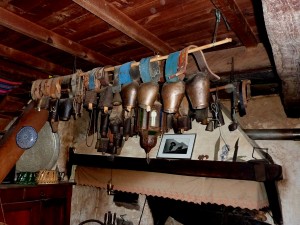

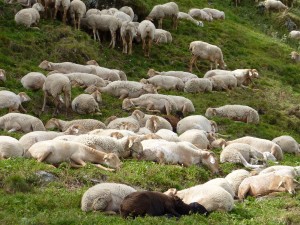
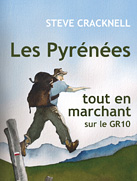
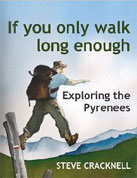

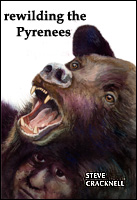



Footprints on the mountains